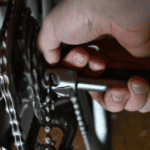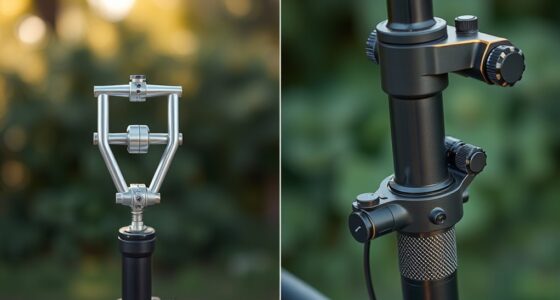Maintaining your mountain bike involves regular checks of tires, brakes, and drivetrain to guarantee peak performance and safety. Inspect and clean components frequently, keep tires properly inflated, and lubricate moving parts to prevent wear. Tighten bolts and fasteners, and monitor for signs of damage or wear, replacing parts when needed. Consistent maintenance prolongs your bike’s lifespan and boosts confidence on every trail—if you want to learn more, keep exploring these essential tips.
Key Takeaways
- Perform regular pre-ride inspections, including tire pressure, brake function, and visual checks for damage or loose parts.
- Clean and lubricate drivetrain components frequently to ensure smooth shifting and prevent premature wear.
- Check and maintain tire condition, pressure, and wheel trueness to optimize grip and ride stability.
- Monitor brake pads, rotors, and cables for wear or damage, replacing parts as needed for safety.
- Service suspension components periodically, including oil changes and seal inspections, for optimal handling and comfort.
The Importance of Regular Maintenance for Mountain Bikes
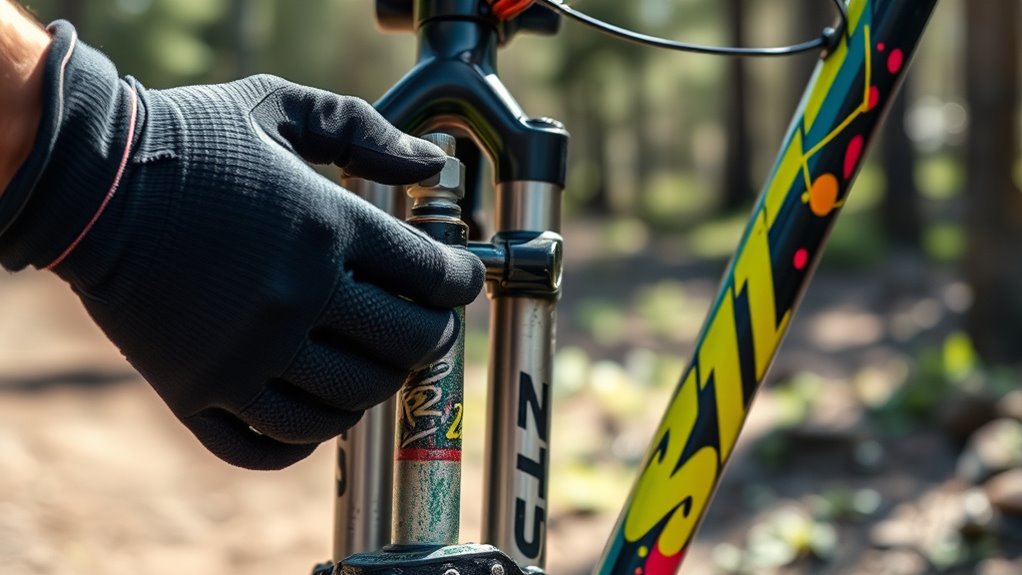
Regular maintenance is essential for keeping your mountain bike in top condition and ensuring safe, enjoyable rides. Sticking to a regular schedule for bike maintenance helps prevent wear and tear, which extends the lifespan of your components. By performing routine checks, you can catch issues early before they turn into costly or dangerous repairs. Consistent upkeep also guarantees your bike performs at its best, offering smoother rides and better handling over tough terrains. Plus, following a regular schedule reduces the risk of mechanical failures during rides, keeping you safe on challenging trails. When you prioritize regular maintenance, you maintain peak bike performance and enjoy more confident, trouble-free adventures. A well-maintained bike is key to every great ride. Incorporating data-driven strategies into your maintenance routine can help you track and optimize your bike’s performance over time. Additionally, understanding the importance of component health ensures that critical parts like brakes, gears, and suspension stay reliable and effective. Regular inspections can also help you stay aware of wear and tear, allowing for timely replacements and adjustments.
Essential Pre-Ride Checks and Inspections
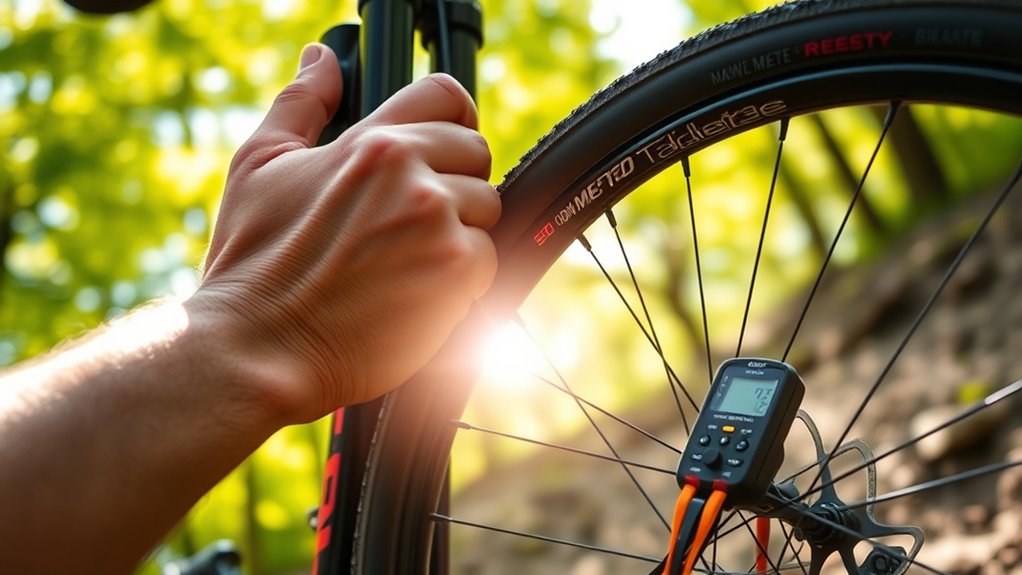
Before each ride, take a moment to inspect your bike for any visible damage or loose parts. Check that your tires are inflated to the recommended PSI, and test your brakes to guarantee they engage smoothly. Also, examine the chain for dirt or rust, and make sure quick-release levers and axles are tight. If you notice any issues, consider routine maintenance to keep your bike in optimal condition. Staying aware of data privacy challenges can help you implement better security measures for your equipment. Additionally, inspecting your projector setup can prevent potential issues during your viewing experience. Regularly reviewing your bike components can help ensure everything functions properly and prolong the lifespan of your mountain bike. Being mindful of environmental concerns like sand and dust can also help prevent damage to your bike’s moving parts.
Tire Pressure Verification
Ensuring your tires are properly inflated is a vital step in preparing your mountain bike for a ride. Correct tire pressure impacts traction, control, and comfort, so it’s essential to check it before every ride. Use a reliable pressure gauge to verify the PSI, aiming for the manufacturer’s recommended range printed on the tire sidewall. Under-inflated tires can cause pinch flats and sluggish handling, while over-inflated tires reduce grip and risk rim damage on rough terrain. Adjust tire pressure based on trail conditions: lower PSI for muddy or technical trails to improve grip, higher PSI for smoother surfaces for speed. Regularly verifying tire pressure helps you maintain peak performance and safety for your mountain bikes during every ride. Additionally, knowing the best airless paint sprayers can be useful if you’re considering maintenance or upgrades to your bike’s components with a smooth, even finish. Proper tire pressure also enhances your overall bike handling, making your rides safer and more enjoyable.
Brake and Chain Check
Performing a brake and chain check is essential for a safe and smooth ride. Start by testing both front and rear brake levers to ensure they engage firmly without excessive pull, indicating proper tension. Inspect the brake pads for remaining material; replace them if they’re below 3mm to maintain stopping power. Check that brake rotors are true, free of warps or debris, and wipe them with alcohol to remove oil or dirt that could cause squealing. Next, examine your chain for tightness, rust, or dirt, and lubricate if needed. Confirm that brake cables are properly tensioned, frays are absent, and there’s no corrosion. Regularly inspecting your Volkswagen Tuning components can also help prevent unexpected issues on the trail. Finally, spin the wheels and apply brakes simultaneously to verify consistent, reliable stopping response. Incorporating regular sound healing practices can also promote mental clarity and focus during your rides. This check keeps your bike ready for the trail.
How to Properly Clean and Lubricate Your Bike
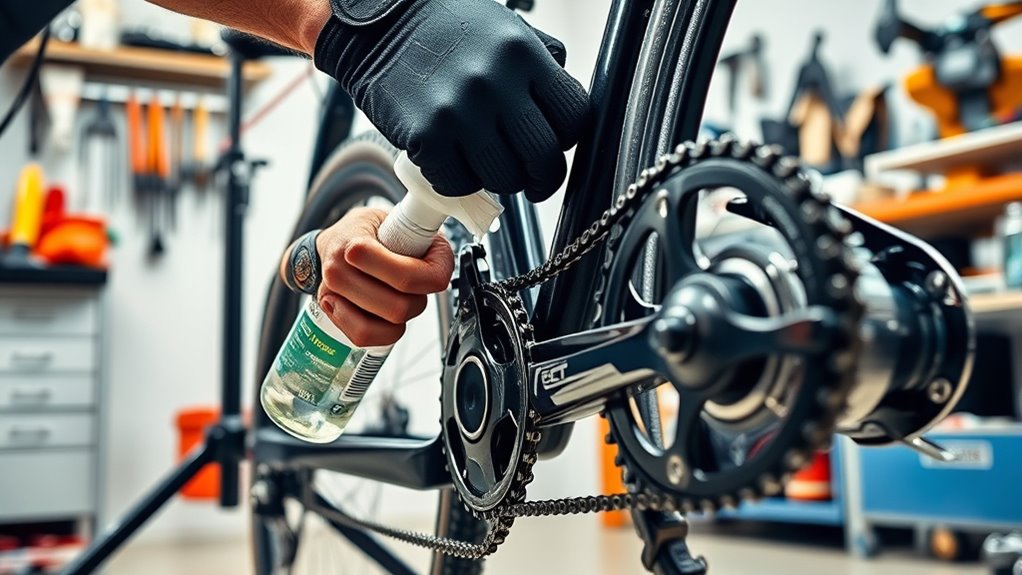
To keep your bike running smoothly, you need the right cleaning supplies and techniques. Using a bike-specific degreaser and brushes helps remove dirt from the chain and drivetrain effectively, while rinsing gently prevents damage. Afterward, proper lubrication guarantees all moving parts function smoothly and last longer. For optimal results, consider applying lubrication tailored to mountain biking to protect your components from dirt and moisture. Additionally, choosing the right cleaning tools can make the process more efficient and thorough. Regular maintenance and understanding the divorce process can also help ensure a smooth transition, much like maintaining a well-functioning bike. Using high-quality airless paint sprayers ensures a smooth finish and reduces overspray, which can be helpful when painting or touch-up work on your bike frame or accessories.
Cleaning Supplies Needed
Cleaning your mountain bike effectively requires gathering the right supplies. To guarantee a thorough bike clean, you’ll need a few essential tools and products. Start with soft brushes and rags to gently remove dirt without damaging delicate parts. Use a bucket of mild soapy water to loosen grime and make the cleaning process easier. Apply bike-specific degreasers and lubricants to protect your components and keep your bike running smoothly. Remember, avoiding high-pressure hoses is vital, as they can force water into bearings and seals, causing damage. Additionally, understanding vacuum cleaner performance metrics can help you choose suitable cleaning tools that won’t harm your bike’s sensitive components. Selecting the right cleaning tools ensures effective maintenance without risking damage. Using tools with appropriate airflow and suction capabilities can enhance cleaning efficiency while protecting your bike. With these supplies, you’ll feel confident in your ability to keep your bike clean and well-maintained. The right tools make all the difference in preserving your mountain bike’s performance and longevity.
Effective Cleaning Techniques
When it’s time to clean your mountain bike, start by using a gentle stream of water combined with bike-specific soap to loosen dirt without risking damage. Focus on chain cleaning and other drivetrain components—cassette, chainrings, and derailleur—using degreaser and brushes to remove stubborn grime. Be thorough but gentle, ensuring all debris is removed from hard-to-reach areas. After cleaning the drivetrain, wipe down the entire bike with a clean, damp cloth, paying special attention to pivot points and brake areas. Dry the bike thoroughly to prevent rust, especially on metal parts and in tricky spots. Once dry, properly cleaned chains should be lubricated with a suitable bike lubricant, then wiped to remove excess, keeping your bike running smoothly. Additionally, understanding proper cleaning techniques can help prevent damage and ensure your bike performs optimally over time. Regularly inspecting and replacing worn components, such as filters or lubricants, can further prolong your bike’s lifespan and improve performance.
Proper Lubrication Practices
Proper lubrication starts with thoroughly cleaning your bike’s chain and drivetrain components to remove dirt and old grease. Use a degreaser to break down grime, ensuring your chain is spotless. Once clean, apply bike-specific lubricant to the inner side of the chain while pedaling slowly, focusing on the rollers and pins. Wipe off any excess lubricant with a dry cloth to prevent dirt and grime from sticking. Remember to lubricate other moving parts like derailleurs, brake levers, and cables periodically to keep everything functioning smoothly. Adjust how often you lubricate based on riding conditions—after wet or muddy rides, increase lubrication to protect your bike’s performance.
- Keep your chain smooth and reliable
- Prevent rust and corrosion
- Extend your bike’s lifespan
- Ride with confidence every time
Monitoring and Maintaining Tire Pressure and Wheel Condition
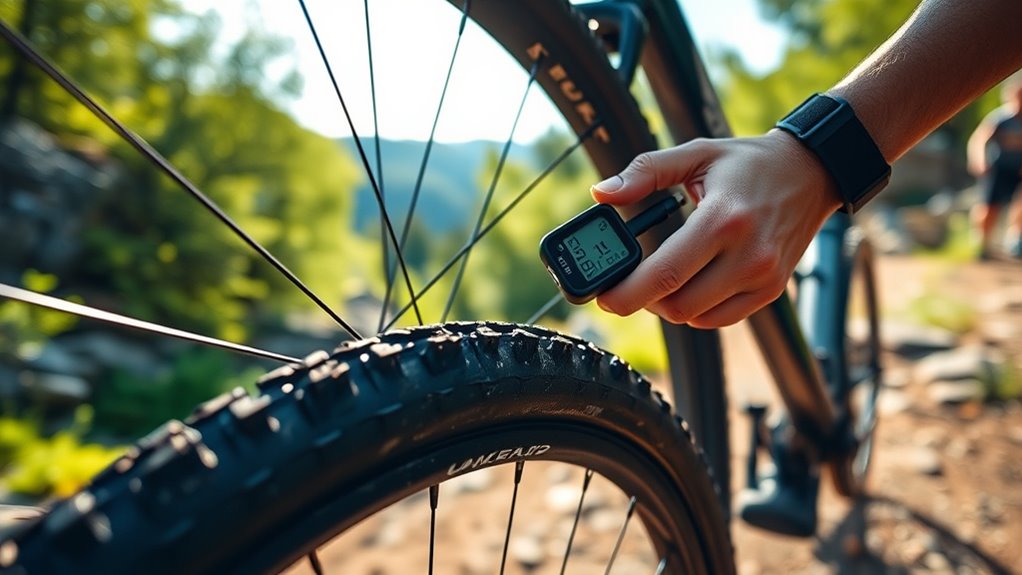
To keep your mountain bike performing at its best, you need to regularly monitor tire pressure and check wheel condition. Ensure your tire pressure matches the PSI listed on the sidewall for ideal grip and efficiency. Use a reliable pressure gauge, especially after long rides or temperature changes, to get an accurate reading. Examine your wheels by spinning them to spot rim wobble or side-to-side movement; true wheels if needed to prevent wobbling and uneven wear. Inspect tires for cuts, embedded debris, or excessive wear that could compromise safety, replacing them if damaged. Additionally, check spoke tension periodically to maintain wheel strength. Properly maintaining tire pressure and wheel condition keeps your ride smooth, safe, and efficient on every trail.
Checking and Adjusting Brakes and Gear Systems

After checking your tire pressure and wheel condition, turn your attention to the braking and gear systems to guarantee responsive and reliable performance. Inspect your brake pads, ensuring at least 3 mm of friction material remains—replace them if worn down. Test your brake levers for proper engagement; adjust cable tension if they feel too loose or tight. Spin the wheels to check rotor alignment, making sure there’s no rubbing or wobbling; true or replace rotors as needed. Clean calipers and rotors with isopropyl alcohol to remove contamination that can cause squealing or reduce braking power. For your gear systems, re-tension derailleurs and cables to achieve smooth shifting, fixing sluggish or noisy shifts. Keep your brake pads and gear systems in top shape for safe, confident rides.
Servicing Suspension Components and Shock Absorbers

Servicing your suspension components is essential for maintaining ideal bike performance and ride comfort. Regular suspension servicing ensures your shock absorbers and forks function smoothly, providing optimal damping and handling. Check and replace fork and shock oil every 50-100 hours of riding to keep the suspension responsive. Inspect seals for leaks and dirt buildup, which can cause contamination and impair performance. After muddy rides, clean and lubricate stanchions and seals to prolong their lifespan and maintain responsiveness. Replacing suspension bushings and seals as recommended by the manufacturer helps prevent play and keeps your ride smooth. Adjusting suspension settings for your weight and riding style further enhances shock absorption and handling, ensuring you get the most out of your bike on every trail.
Tightening Bolts, Nuts, and Other Fasteners
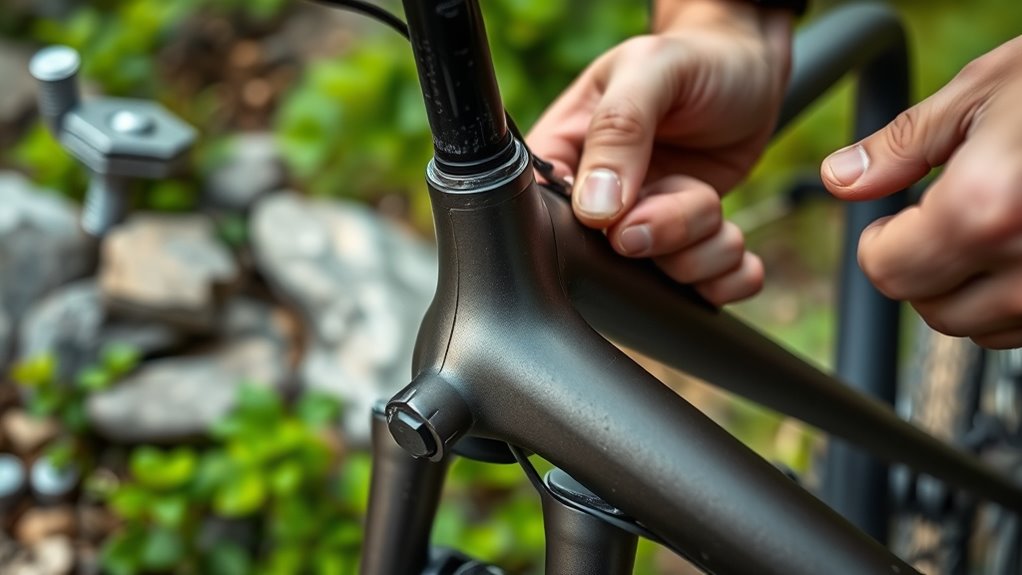
Ensuring all bolts, nuts, and fasteners are properly tightened is crucial for your bike’s safety and performance. Regularly check components like the stem, handlebars, seat post, and derailleur to verify they’re secure. Use a torque wrench for critical fasteners—especially on disc brake rotors and thru-axles—to avoid over- or under-tightening, which can cause damage or safety issues. Loose bolts can lead to component failure, excessive wear, or accidents, so make bolt tightening part of your pre- and post-ride routine. Remember, different materials like aluminum, steel, or carbon need specific torque limits—refer to your owner’s manual. After riding rough terrain or suspensions service, recheck fasteners to prevent vibrations from loosening them over time. Stay vigilant, stay safe.
Scheduling Routine Professional Servicing and Repairs
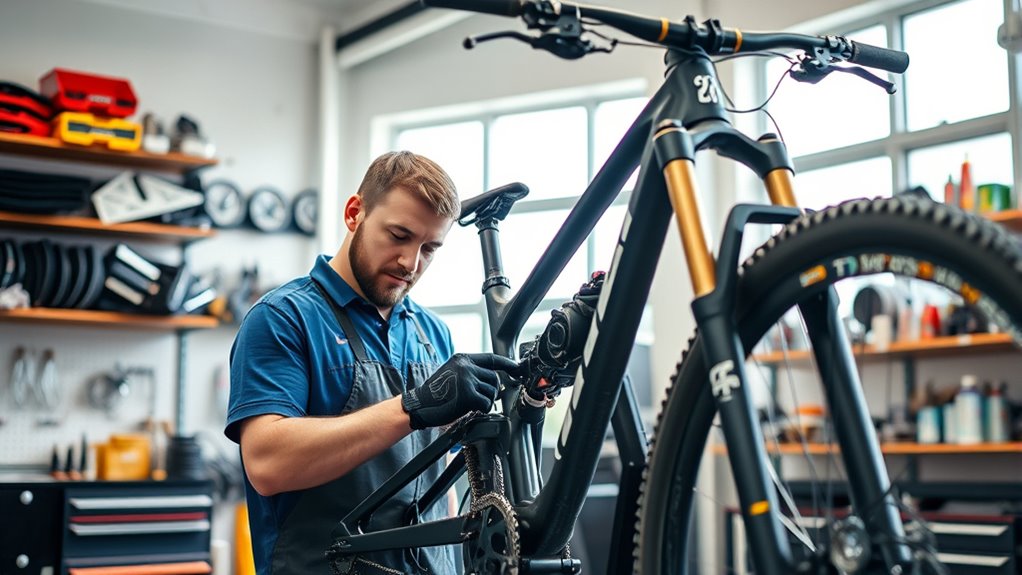
Scheduling regular professional service keeps your bike in top shape and helps catch issues early. Most shops recommend a tune-up every six months or after about 100-150 rides, especially for critical parts like brakes and bearings. Staying on top of these visits guarantees your bike performs safely and lasts longer.
Regular Service Intervals
Regularly scheduling professional tune-ups is key to keeping your mountain bike in top shape and preventing costly repairs down the line. By sticking to regular maintenance intervals, you can catch issues early and ensure smooth rides. Consider these essential service points:
- Check chain stretch, brake pad wear, and suspension performance every 10 to 15 rides
- Conduct semiannual inspections of cables, bearings, and tires
- Arrange an annual full-service for brake bleed and suspension upkeep
- Perform as-needed repairs like replacing worn components or tightening bolts
These routine professional services give you peace of mind and keep your bike performing at its best. Skipping scheduled maintenance can lead to unexpected breakdowns and expensive repairs, so stay proactive and schedule your service intervals consistently.
Identifying Repair Needs
How can you effectively identify when your mountain bike needs professional servicing? Keep an eye on your chain’s condition—if it’s stretched or showing signs of excessive wear and tear, it’s time for a tune-up. Regularly inspect brake pads, suspension, and drivetrain components for any issues that could compromise performance. If you notice your bike isn’t shifting smoothly, wheels aren’t true, or tires are showing uneven wear, schedule repairs promptly. Tracking riding hours with apps or logs helps determine when suspension needs servicing, typically after a set number of hours. Addressing these signs early prevents further damage and costly repairs. Consulting your bike’s manual or a mechanic regularly ensures you stay ahead of potential problems and maintain peak performance.
Professional Maintenance Benefits
By keeping an eye on your bike’s condition and addressing minor issues early, you can prevent larger problems down the line. Scheduling routine professional maintenance guarantees critical components like bearings, suspension, and brakes are properly serviced, extending their lifespan. Regular professional tune-ups help you catch issues before they become costly repairs or safety hazards. These services include precise adjustments and inspections that often require specialized tools and expertise beyond DIY skills. Investing in professional maintenance keeps your bike performing at its best and reduces unexpected breakdowns. When you keep your bike properly maintained, you enjoy:
- Safer, smoother rides
- Longer-lasting components
- Fewer costly repairs
- Greater resale value
Keeping your bike in top shape through professional services keeps you confident and ready for any trail.
Recognizing Signs of Wear and When to Replace Parts
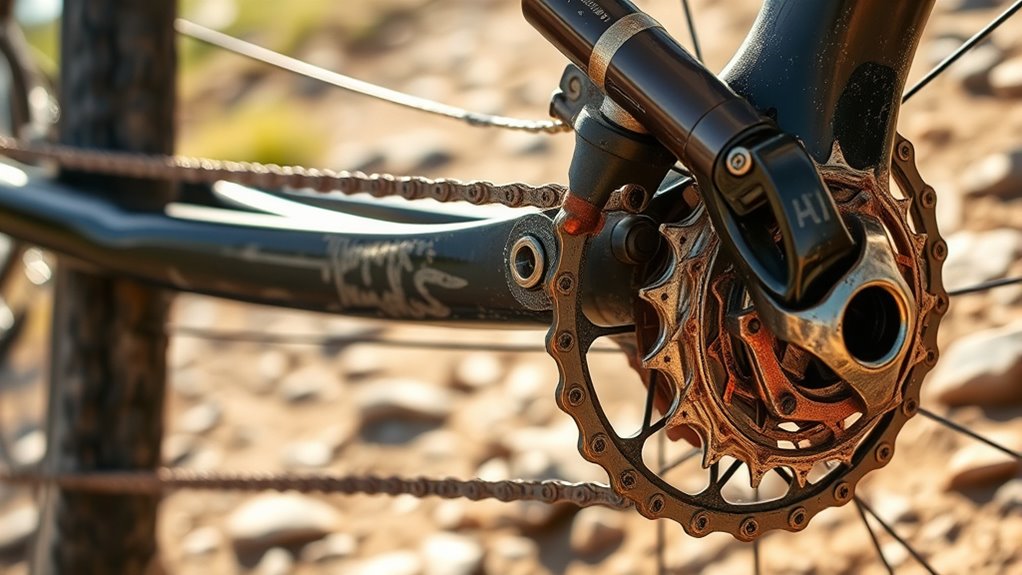
Knowing when to replace bike parts is essential for safe and efficient riding. Worn brake pads with less than 1.5 mm of material reduce stopping power and pose safety risks. Look for cracks or dents in rims, especially around the bead, which can cause wheel failure. Excessive chain stretch over 0.5% signals it’s time for a new chain to prevent damage to sprockets and derailleur parts. Loose or wobbly headset or bottom bracket affects steering and should be replaced promptly. Rust, corrosion, or frayed cables indicate deterioration, risking mechanical failure. Use this quick reference:
| Part of the Bike | Warning Signs |
|---|---|
| Brake rotor | Warping, deep grooves, or cracks |
| Chain | Over 0.5% stretch, stiff links |
| Rims | Cracks, dents, or bead damage |
| Cables & Housing | Fraying, rust, or corrosion |
Tips for Safe and Effective On-the-Trail Bike Care

Ensuring your mountain bike is ready for the trail starts with a quick pre-ride ABC check. This simple step can prevent accidents and gear failures. Before heading out, verify that your tire pressure is correct, your brakes respond promptly, and your chain is well-lubricated. Carry essential tools like a multitool, tire levers, and a pump—these can save your ride from unexpected issues. Regularly inspect and tighten fasteners such as quick-release levers and axle bolts to avoid safety hazards. Keep your drivetrain clean and lubricated to ensure smooth shifting and prevent dirt buildup.
Remember, a prepared bike boosts your confidence and safety on the trail.
- Feel the thrill, not the worry
- Confidently tackle every obstacle
- Ride with peace of mind
- Conquer trails safely and effectively
Frequently Asked Questions
Is a Mountain Bike Chain Guide Worth It?
You might wonder if a mountain bike chain guide is worth it. If you ride technical trails, do jumps, drops, or downhill racing, a chain guide can keep your chain in place, preventing derailments and reducing wear on your drivetrain. While it adds weight and complexity, it’s a smart investment for aggressive riding styles. For casual or cross-country riders, however, it might be an unnecessary upgrade.
How Often Should a Mountain Bike Be Serviced?
You might think your mountain bike is invincible, but it actually needs regular care to keep performing like a dream. Typically, you should do a basic tune-up every 10 to 15 rides or about once a month. For more thorough maintenance, plan a professional service every six months or after roughly 100 hours of riding. Always check brakes, tires, and bolts before and after rides, especially if conditions are muddy or wet.
Are Mountain Bikes High Maintenance?
You might wonder if mountain bikes are high maintenance. The answer is yes, they generally are more demanding than road bikes because of rough terrain, dirt, and mud that accelerate wear. You need to check tires, brakes, and suspension regularly, clean and lubricate after rides, and sometimes seek professional help for complex repairs. While some tasks are simple, staying on top of maintenance keeps your bike safe and performing well.
Is It Worth Getting Bike Serviced?
You might think getting your bike serviced is a waste of time, but imagine riding over rough terrain only to have your brakes fail. Regular professional servicing keeps your mountain bike in top shape, preventing costly repairs and ensuring safety. It’s a small investment that pays off by improving performance, extending your bike’s lifespan, and making every ride smoother and more enjoyable—so yes, it’s absolutely worth it.
Conclusion
Regular maintenance keeps your mountain bike performing at its best and extends its lifespan. Think of your bike like a car—neglect can lead to costly repairs or accidents. By consistently checking, cleaning, and tuning your bike, you guarantee safety and reliability on every ride. Imagine skipping oil changes; your engine suffers. Similarly, neglecting bike care causes wear and tear. Stay proactive, and your mountain biking adventures will be smoother, safer, and more enjoyable.







